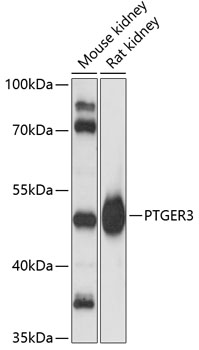Signal Transduction Antibodies 2
Anti-PTGER3 Antibody (CAB4057)
- SKU:
- CAB4057
- Product Type:
- Antibody
- Reactivity:
- Mouse
- Reactivity:
- Rat
- Host Species:
- Rabbit
- Isotype:
- IgG
- Research Area:
- Signal Transduction
Description
| Antibody Name: | Anti-PTGER3 Antibody |
| Antibody SKU: | CAB4057 |
| Antibody Size: | 20uL, 50uL, 100uL |
| Application: | WB |
| Reactivity: | Mouse, Rat |
| Host Species: | Rabbit |
| Immunogen: | Recombinant fusion protein containing a sequence corresponding to amino acids 1-53 of human PTGER3 (NP_942009.1). |
| Application: | WB |
| Recommended Dilution: | WB 1:500 - 1:2000 |
| Reactivity: | Mouse, Rat |
| Positive Samples: | Mouse kidney, Rat kidney |
| Immunogen: | Recombinant fusion protein containing a sequence corresponding to amino acids 1-53 of human PTGER3 (NP_942009.1). |
| Purification Method: | Affinity purification |
| Storage Buffer: | Store at -20'C. Avoid freeze / thaw cycles. Buffer: PBS with 0.02% sodium azide, 50% glycerol, pH7.3. |
| Isotype: | IgG |
| Sequence: | MKET RGYG GDAP FCTR LNHS YTGM WAPE RSAE ARGN LTRP PGSG EDCG SVSV A |
| Gene ID: | 5733 |
| Uniprot: | P43115 |
| Cellular Location: | Cell membrane, Multi-pass membrane protein |
| Calculated MW: | 40kDa/41kDa/42kDa/43kDa/44kDa/46kDa/47kDa |
| Observed MW: | 50kDa |
| Synonyms: | PTGER3, EP3, EP3-I, EP3-II, EP3-III, EP3-IV, EP3-VI, EP3e, PGE2-R |
| Background: | The protein encoded by this gene is a member of the G-protein coupled receptor family. This protein is one of four receptors identified for prostaglandin E2 (PGE2). This receptor may have many biological functions, which involve digestion, nervous system, kidney reabsorption, and uterine contraction activities. Studies of the mouse counterpart suggest that this receptor may also mediate adrenocorticotropic hormone response as well as fever generation in response to exogenous and endogenous stimuli. Multiple transcript variants encoding different isoforms have been found for this gene. |
| UniProt Protein Function: | PTGER3: Receptor for prostaglandin E2 (PGE2); the EP3 receptor may be involved in inhibition of gastric acid secretion, modulation of neurotransmitter release in central and peripheral neurons, inhibition of sodium and water reabsorption in kidney tubulus and contraction in uterine smooth muscle. The activity of this receptor can couple to both the inhibition of adenylate cyclase mediated by G-I proteins, and to an elevation of intracellular calcium. The various isoforms have identical ligand binding properties but can interact with different second messenger systems. Belongs to the G-protein coupled receptor 1 family. 7 isoforms of the human protein are produced by alternative splicing. |
| UniProt Protein Details: | Protein type:Membrane protein, multi-pass; Receptor, GPCR; Membrane protein, integral; GPCR, family 1 Chromosomal Location of Human Ortholog: 1p31.2 Cellular Component: integral to plasma membrane; plasma membrane; integral to membrane; nuclear envelope Molecular Function:ligand-dependent nuclear receptor activity; prostaglandin E receptor activity Biological Process: G-protein signaling, coupled to cAMP nucleotide second messenger; cell death; G-protein coupled receptor protein signaling pathway; elevation of cytosolic calcium ion concentration; intracellular receptor-mediated signaling pathway; transcription, DNA-dependent; bicarbonate transport; positive regulation of fever; response to lipopolysaccharide; G-protein signaling, coupled to IP3 second messenger (phospholipase C activating); fever |
| NCBI Summary: | The protein encoded by this gene is a member of the G-protein coupled receptor family. This protein is one of four receptors identified for prostaglandin E2 (PGE2). This receptor may have many biological functions, which involve digestion, nervous system, kidney reabsorption, and uterine contraction activities. Studies of the mouse counterpart suggest that this receptor may also mediate adrenocorticotropic hormone response as well as fever generation in response to exogenous and endogenous stimuli. Multiple transcript variants encoding different isoforms have been found for this gene. [provided by RefSeq, Aug 2009] |
| UniProt Code: | P43115 |
| NCBI GenInfo Identifier: | 119626851 |
| NCBI Gene ID: | 5733 |
| NCBI Accession: | EAX06446.1 |
| UniProt Secondary Accession: | P43115,O00326, Q12943, Q12944, Q12945, Q16546, Q5CZ59 Q5CZ62, Q5CZ63, Q5CZ64, B0AZN4, B5BUP5, |
| UniProt Related Accession: | P43115 |
| Molecular Weight: | 46,849 Da |
| NCBI Full Name: | prostaglandin E receptor 3 (subtype EP3), isoform CRA_k |
| NCBI Synonym Full Names: | prostaglandin E receptor 3 (subtype EP3) |
| NCBI Official Symbol: | PTGER3 |
| NCBI Official Synonym Symbols: | EP3; EP3e; EP3-I; EP3-II; EP3-IV; PGE2-R; EP3-III |
| NCBI Protein Information: | prostaglandin E2 receptor EP3 subtype; prostanoid EP3 receptor; PGE receptor, EP3 subtype; PGE2 receptor EP3 subtype; prostaglandin receptor (PGE-2); prostaglandin E receotor EP3 subtype 3 isoform |
| UniProt Protein Name: | Prostaglandin E2 receptor EP3 subtype |
| UniProt Synonym Protein Names: | PGE2-R; Prostanoid EP3 receptor |
| Protein Family: | Endochitinase |
| UniProt Gene Name: | PTGER3 |
| UniProt Entry Name: | PE2R3_HUMAN |







